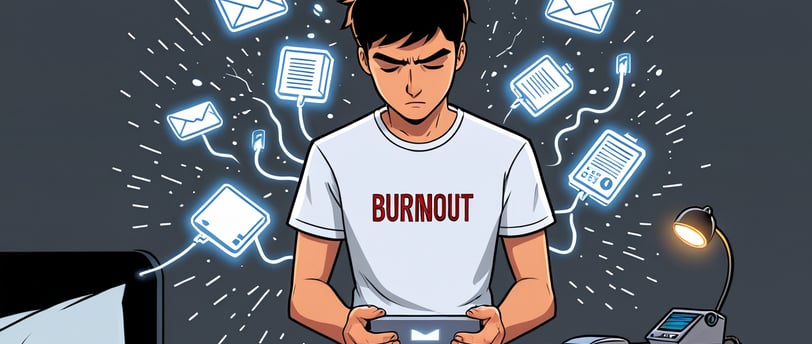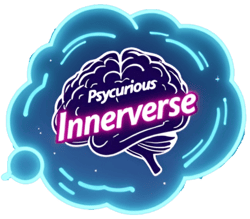What Is Burnout—and Why Does It Happen?
Burnout isn’t just about being tired—it’s a deep response to prolonged stress that impacts your emotions, energy, and productivity. Here, we’ll explore what burnout really is, why it happens, and how you can recognize the signs before it takes hold. Understanding burnout is the first step toward finding balance and reclaiming your spark.
1/1/20257 min read


Introduction: The Battery Inside Your Brain
In a world teeming with notifications, deadlines, and constant demands, it’s easy to feel like we’ve signed an endless contract of productivity. Picture your mental energy as a glowing battery encased within your brain: each morning, you begin with some finite amount of charge. Yet, unlike a phone you can plug in overnight for a guaranteed 100% recharge, the human mind isn’t quite so simple. When life’s demands routinely exceed your capacity to recover, your mental “battery” doesn’t just run low—it can burn out entirely.
Burnout is far more than mere tiredness at the end of a busy day. It’s a deep, often disorienting experience where exhaustion meets a loss of purpose. Whether you’re a corporate employee juggling back-to-back Zoom meetings or a college student navigating exams, understanding what burnout is—and why it happens—can be a crucial first step in regaining balance.
In this article, we’ll expand upon the “burnout script” you may have watched in a short video format, offering a deeper dive into the mechanisms, warning signs, and societal factors fueling burnout. Here, you’ll also find extra references and insights that can guide you toward healthier coping strategies.
Part I: Defining Burnout—A Modern Epidemic
Burnout is officially recognized by the World Health Organization (WHO) as an “occupational phenomenon” stemming from chronic workplace stress that has not been successfully managed. However, experts like Christina Maslach, a pioneering researcher in the field of burnout, and Dr. Herbert Freudenberger, who introduced the term “burnout” in the 1970s, emphasize that it can develop in any scenario where prolonged stress overwhelms a person’s coping mechanisms.
Key Dimensions of Burnout (as identified by Christina Maslach):
Emotional Exhaustion: Feeling completely drained, lacking the energy to face the day.
Depersonalization: A sense of detachment or cynicism toward your work, your peers, or the activities you once enjoyed.
Reduced Personal Accomplishment: A sense that nothing you do is ever “good enough,” leading to persistent self-doubt.
Far from being a mere buzzword, burnout weaves itself into various facets of life. It can appear in caregiving (as “compassion fatigue”), academia (as “academic burnout”), or even personal hobbies turned obligations. Think of it as your brain waving a white flag, pleading for rest, renewal, and a reevaluation of priorities.
Part II: Why Does Burnout Happen?
The Evolutionary Mismatch
Our ancestors operated in environments where acute stress (like escaping a predator) was followed by periods of rest and recovery. In modern society, however, many of us are subjected to chronic low-grade stress—constant pings from work, social media comparisons, or looming financial worries. This mismatch between our prehistoric biology and the relentless pace of 21st-century life can place our nervous systems in a near-constant state of alert.Infinite “To-Do” Lists
Whether at work or at home, tasks often accumulate faster than we can complete them. This overload, combined with the pressure to do more with less time, sets the perfect stage for burnout. A 2017 survey by the American Psychological Association (APA) found that over 50% of Americans reported feeling stressed due to work demands. When these tasks stretch into evenings and weekends, genuine downtime becomes scarce.Societal Pressures and ‘Hustle Culture’
We live in an era that glamorizes busyness and productivity, promoting the idea that we should constantly “grind.” Terms like “hustle culture” and “grindset” don’t just raise expectations; they normalize burnout as a badge of honor. Meanwhile, social media often showcases highlight reels of success and productivity, fueling the notion that we must never slow down.
Part III: The Physiology of Burnout—What Happens Inside the Brain
Cortisol Overload
Cortisol, often called the “stress hormone,” is vital for short-term threats—like prepping your body to outrun a tiger. But in a world where emails and notifications replace tigers, cortisol can linger. Chronic cortisol elevation contributes to fatigue, disrupted sleep, and even immune suppression. Studies indicate that constantly high cortisol levels correlate with diminished cognitive function and emotional well-being over time.When the Prefrontal Cortex Goes Offline
The prefrontal cortex (PFC) governs critical thinking, decision-making, and impulse control. Under prolonged stress, the PFC’s function erodes, making it harder to plan, stay motivated, or adapt to new information. Meanwhile, the amygdala, which regulates fear and stress responses, starts running the show. Consequently, everyday tasks that once seemed routine can feel insurmountable. This neurological interplay underscores why burnout feels both mentally and emotionally overwhelming.Body in Revolt
Chronic stress isn’t just a mental phenomenon; it plays havoc with your physical health as well. Research in the journal Psychoneuroendocrinology links sustained stress responses to problems like high blood pressure, digestive issues, and chronic pain. In the workplace, a cycle emerges: the more physically unwell you become, the less work you can manage, fueling an even deeper sense of burnout.
Part IV: Warning Signs of Impending Burnout
Burnout doesn’t strike overnight; it usually announces itself in subtler ways first. Look out for:
Constant Fatigue: Feeling “drained” every day, even after decent sleep.
Increased Irritability: Minor inconveniences or small tasks trigger disproportionate anger or frustration.
Emotional Numbness: A sense of detachment or lack of enjoyment in previously loved activities.
Physical Complaints: Unexplained headaches, muscle tension, stomachaches—all can be stress-related.
Loss of Motivation: Activities once driven by passion now feel more like obligatory chores.
If these warning signs resonate, consider it a blinking red light on the dashboard of your mental energy.
Part V: The Cultural Landscape—How Society Fuels Burnout
1. Hustle Culture & Social Media
Social media platforms can be amplifiers of burnout. Images of others’ successes can heighten feelings of inadequacy or self-criticism, especially when you’re already running on empty. This can lead to the misconception that everyone else is handling life effortlessly while you struggle.
2. Perfectionism & External Expectations
Many of us strive for ideals in our careers and personal lives that are simply unsustainable. This constant chase for perfection leaves little room for rest or acceptance of human error.
3. Always-Connected Work Environments
Emails, chats, and project management tools make it possible to reach you anytime, anywhere. The boundary between work hours and personal life keeps eroding, making true rest increasingly elusive.
Part VI: Steps to Reclaim Your Energy—Recovery and Prevention
Recognizing you’re on the path to burnout is half the battle. The next half involves strategic, deliberate actions:
Set Boundaries
Define clear “off” hours and communicate them to coworkers, friends, and family. Gently push back against after-hours emails or texts to safeguard your personal time.
Pursue Meaningful Rest
Rest isn’t just about sleeping; it’s about engaging in activities that genuinely recharge you, whether it’s painting, reading, or going for a mindful walk. This deliberate “active rest” reclaims energy and refuels your mental battery.
Practice Mindfulness & Meditation
Techniques such as deep breathing, progressive muscle relaxation, or guided visualization can reduce the hyperactivity of your amygdala. A 2014 meta-analysis in JAMA Internal Medicine found mindfulness programs to be effective in reducing stress, anxiety, and even mild depression.
Seek Social Support
Human connection often softens stress. A listening ear or shared laughter can act as an emotional safety valve. If feasible, consult a mental health professional who can offer personalized coping strategies.
Redefine Success
Instead of tying your self-worth to output, consider celebrating smaller wins or personal growth. Emphasize quality over quantity, and remember that a break is not a failure—it’s a basic need.
Adopt Healthier Habits
Good nutrition, regular exercise, and proper sleep form the bedrock of mental resilience. Something as simple as a 10-minute walk in nature can help lower cortisol levels and clear mental fog.
Part VII: Creating a Sustainable Future—Beyond Burnout
Balancing “Stress” with “Recovery”
Think of your day as a dance between stress and rest. Short work sprints, punctuated by meaningful breaks, not only prevent burnout but also enhance productivity in the long run.
Cultural Shift
Moving away from “hustle culture” requires both societal and individual efforts. Advocates and forward-thinking companies are now exploring flexible work hours, mental health days, and well-being programs as essential tools in combatting burnout on a systemic level.
Global Perspective
Countries like Sweden and Denmark are frequently cited for better work-life balance, showing that alternative models of employment can reduce burnout rates. Observing and learning from such societal frameworks might offer a roadmap for broader change.
Part VIII: Final Thoughts—Recharging the Human Battery
Burnout is not a sign of weakness or laziness. It’s your mind’s way of announcing it has reached its limit. When you consistently operate beyond healthy boundaries, your mental battery can’t simply be plugged in and recharged overnight. Recovery is a conscious process: one that involves recalibrating expectations, building supportive environments, and allowing genuine downtime for body and mind.
The takeaway? You have the power to steer your life away from chronic burnout by nurturing self-awareness, setting firm boundaries, and validating your own need for rest. Because even in a universe that never seems to pause, each of us deserves—and needs—moments of stillness.
Want to Dive Deeper?
Read Burnout: The Secret to Unlocking the Stress Cycle by Emily and Amelia Nagoski for more insights on stress management.
Explore resources from the American Psychological Association for evidence-based interventions.
Listen to experts like Dr. Gabor Maté, who delve into the body’s stress signals and emotional health.
Burnout can feel isolating, but remember: you’re not alone, and there are strategies, resources, and communities ready to help you reclaim your peace of mind.
Liked This In-Depth Article?
Share it with friends or colleagues who might need a reminder that their human limitations are valid.
Comment below with your personal burnout experiences or any strategies that have worked for you.
Subscribe to our blog or channel for more mind-expanding explorations into psychology, well-being, and the wonders of the cosmos. Because when we understand our minds better, we can navigate the galaxy of daily life with far more resilience and grace.
References & Citations:
Burnout: The Secret to Unlocking the Stress Cycle: by DMA Amelia Nagoski (Author), PhD Emily Nagoski (Author): https://amzn.to/4gXEXZL
"The Burnout Epidemic" by Jennifer Moss: https://amzn.to/4gHSODR
The Truth About Burnout: How Organizations Cause Personal Stress and What to Do About It: by Christina Maslach (Author), Michael P. Leiter (Author): https://amzn.to/3W5cIQT
"The Stress Response Syndrome" by Dr. Hans Selye (First to Define Stress Physiology): https://pmc.ncbi.nlm.nih.gov/articles/PMC313000/pdf/i1355-8145-002-04-0214.pdf
"Effects of Stress on Brain Structure and Function" – Frontiers in Neuroscience
"Burnout: Modern Conceptualization" – American Psychological Association
